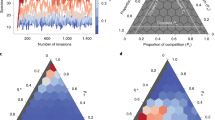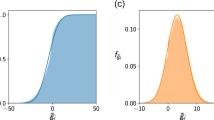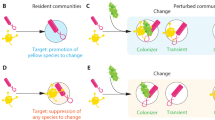Abstract
A central goal of ecological research has been to understand the limits on the maximum number of species that can coexist under given constraints. However, we know little about the assembly and disassembly processes under which a community can reach such a maximum number, or whether this number is in fact attainable in practice. This limitation is partly due to the challenge of performing experimental work and partly due to the lack of a formalism under which one can systematically study such processes. Here, we introduce a formalism based on algebraic topology and homology theory to study the space of species coexistence formed by a given pool of species. We show that this space is characterized by ubiquitous discontinuities that we call coexistence holes (that is, empty spaces surrounded by filled space). Using theoretical and experimental systems, we provide direct evidence showing that these coexistence holes do not occur arbitrarily—their diversity is constrained by the internal structure of species interactions and their frequency can be explained by the external factors acting on these systems. Our work suggests that the assembly and disassembly of ecological systems is a discontinuous process that tends to obey regularities.
This is a preview of subscription content, access via your institution
Access options
Access Nature and 54 other Nature Portfolio journals
Get Nature+, our best-value online-access subscription
$29.99 / 30 days
cancel any time
Subscribe to this journal
Receive 12 digital issues and online access to articles
$119.00 per year
only $9.92 per issue
Buy this article
- Purchase on Springer Link
- Instant access to full article PDF
Prices may be subject to local taxes which are calculated during checkout





Similar content being viewed by others
Data availability
All of the data analysed in this study are publicly available.
Code availability
The code supporting the results is archived in the GitHub repository at https://syntheticdynamics.github.io/CoexistenceHoles.jl.
References
Fukami, T. Historical contingency in community assembly: integrating niches, species pools, and priority effects. Annu. Rev. Ecol. Evol. Syst. 46, 1–23 (2015).
Tylianakis, J. M., Martínez-García, L. B., Richardson, S. J., Peltzer, D. A. & Dickie, I. A. Symmetric assembly and disassembly processes in an ecological network. Ecol. Lett. 21, 896–904 (2018).
Chase, J. M., Blowes, S. A., Knight, T. M., Gerstner, K. & May, F. Ecosystem decay exacerbates biodiversity loss with habitat loss. Nature 584, 238–243 (2020).
Vellend, M. The Theory of Ecological Communities (MPB-57) (Princeton Univ. Press, 2016).
Hutchinson, G. E. Homage to Santa Rosalia or why are there so many kinds of animals? Am. Nat. 93, 145–159 (1959).
Tilman, D. Resource Competition and Community Structure (Princeton Univ. Press, 1982).
Barbier, M., Arnoldi, J.-F., Bunin, G. & Loreau, M. Generic assembly patterns in complex ecological communities. Proc. Natl Acad. Sci. USA 115, 2156–2161 (2018).
Serván, C. A., Capitán, J. A., Grilli, J., Morrison, K. E. & Allesina, S. Coexistence of many species in random ecosystems. Nat. Ecol. Evol. 2, 1237–1242 (2018).
MacArthur, R. Species packing and competitive equilibrium for many species. Theor. Popul. Biol. 1, 1–11 (1970).
Medeiros, L. P., Boege, K., del Val, E., Zaldivar-Riverón, A. & Saavedra, S. Observed ecological communities are formed by species combinations that are among the most likely to persist under changing environments. Am. Nat. https://doi.org/10.1086/711663 (2020).
Barabás, G., D’Andrea, R. & Stump, S. M. Chesson’s coexistence theory. Ecol. Monogr. 88, 277–303 (2018).
Grainger, T. N. & Gilbert, J. M. L. B. The invasion criterion: a common currency for ecological research. Trends Ecol. Evol. 34, 925–935 (2019).
Alberch, P. The logic of monsters: evidence for internal constraint in development and evolution. Geobios 22, 21–57 (1989).
Clements, F. E. Nature and structure of the climax. J. Ecol. 24, 252–284 (1936).
Odum, E. P. & Barrett, G. W. Fundamentals of Ecology 5th edn (Thomson Brooks/Cole, 2005).
Friedman, J., Higgins, L. M. & Gore, J. Community structure follows simple assembly rules in microbial microcosms. Nat. Ecol. Evol. 1, 0109 (2017).
Chesson, P. Mechanisms of maintenance of species diversity. Annu. Rev. Ecol. Syst. 31, 343–366 (2000).
Drake, J. A. Community-assembly mechanics and the structure of an experimental species ensemble. Am. Nat. 137, 1–26 (1991).
Warren, P. H., Law, R. & Weatherby, A. J. Mapping the assembly of protist communities in microcosms. Ecology 84, 1001–1011 (2003).
Schreiber, S. J. & Rittenhouse, S. From simple rules to cycling in community assembly. Oikos 105, 349–358 (2004).
Chase, J. M. & Leibold, M. A. Ecological Niches: Linking Classical and Contemporary Approaches (Univ. Chicago Press, 2003).
Kraft, N. J. et al. Community assembly, coexistence and the environmental filtering metaphor. Funct. Ecol. 29, 592–599 (2015).
Moore, R., Robinson, W., Lovette, I. & Robinson, T. Experimental evidence for extreme dispersal limitation in tropical forest birds. Ecol. Lett. 11, 960–968 (2008).
Maherali, H. & Klironomos, J. N. Influence of phylogeny on fungal community assembly and ecosystem functioning. Science 316, 1746–1748 (2007).
Serván, C. & Allesina, S. Tractable models of ecological assembly. Ecol. Lett. 24, 1029–1037 (2021).
Rosindell, J., Hubbell, S. P. & Etienne, R. S. The unified neutral theory of biodiversity and biogeography at age ten. Trends Ecol. Evol. 26, 340–348 (2011).
Case, T. J. Surprising behavior from a familiar model and implications for competition theory. Am. Nat. 146, 961–966 (1995).
Saavedra, S. et al. A structural approach for understanding multispecies coexistence. Ecol. Monogr. 87, 470–486 (2017).
Tilman, D. Resources: a graphical-mechanistic approach to competition and predation. Am. Nat. 116, 362–393 (1980).
May, R. M. & Leonard, W. J. Nonlinear aspects of competition between three species. SIAM J. Appl. Math. 29, 243–253 (1975).
Dean, A. M. A simple model of mutualism. Am. Nat. 121, 409–417 (1983).
Song, C., Ahn, S. V., Rohr, R. P. & Saavedra, S. Towards a probabilistic understanding about the context-dependency of species interactions. Trends Ecol. Evol. 35, 384–396 (2020).
Saavedra, S., Medeiros, L. P. & AlAdwani, M. Structural forecasting of species persistence under changing environments. Ecol. Lett. https://doi.org/10.1111/ele.13582 (2020).
Law, R. & Blackford, J. C. Self-assembling food webs: a global viewpoint of coexistence of species in Lotka–Volterra communities. Ecology 73, 567–578 (1992).
Sigmuiud, K. Darwin’s ‘circles of complexity’: assembling ecological communities. Complexity 1, 40–44 (1995).
Law, R. & Morton, R. D. Permanence and the assembly of ecological communities. Ecology 77, 762–775 (1996).
Wilson, J. B., Spijkerman, E. & Huisman, J. Is there really insufficient support for Tilman’s R* concept? A comment on Miller et al. Am. Nat. 169, 700–706 (2007).
May, R. M. Simple mathematical models with very complicated dynamics. Nature 261, 459–467 (1976).
Cenci, S., Song, C. & Saavedra, S. Rethinking the importance of the structure of ecological networks under an environment-dependent framework. Ecol. Evol. 8, 6852–6859 (2018).
O’Dwyer, J. P. Whence Lotka-Volterra? Theor. Ecol. 11, 441–452 (2018).
Levine, J. M., Bascompte, J., Adler, P. B. & Allesina, S.Beyond pairwise mechanisms of species coexistence in complex communities. Nature 546, 56–64 (2017).
Vandermeer, J. H. The competitive structure of communities: an experimental approach with protozoa. Ecology 50, 362–371 (1969).
Stein, R. R. et al. Ecological modeling from time-series inference: insight into dynamics and stability of intestinal microbiota. PLoS Comput. Biol. 9, e1003388 (2013).
Venturelli, O. S. et al. Deciphering microbial interactions in synthetic human gut microbiome communities. Mol. Syst. Biol. 14, e8157 (2018).
Bucci, V. et al. MDSINE: Microbial Dynamical Systems Inference Engine for microbiome time-series analyses. Genome Biol. 17, 121 (2016).
Turelli, M. A reexamination of stability in randomly varying versus deterministic environments with comments on the stochastic theory of limiting similarity. Theor. Popul. Biol. 13, 244–267 (1978).
May, R. M. Stability and Complexity in Model Ecosystems (Princeton Univ. Press, 2019).
Allesina, S. & Tang, S. The stability–complexity relationship at age 40: a random matrix perspective. Popul. Ecol. 57, 63–75 (2015).
Allesina, S. & Tang, S. Stability criteria for complex ecosystems. Nature 483, 205–208 (2012).
Grilli, J., Rogers, T. & Allesina, S. Modularity and stability in ecological communities. Nat. Commun. 7, 12031 (2016).
Hoek, T. A. et al. Resource availability modulates the cooperative and competitive nature of a microbial cross-feeding mutualism. PLoS Biol. 14, e1002540 (2016).
Case, T. J. An Illustrated Guide to Theoretical Ecology (Oxford Univ. Press, 2000).
Freedman, H. & So, J.-H. Global stability and persistence of simple food chains. Math. Biosci. 76, 69–86 (1985).
Posfai, A., Taillefumier, T. & Wingreen, N. S. Metabolic trade-offs promote diversity in a model ecosystem. Phys. Rev. Lett. 118, 028103 (2017).
Gould, A. L. et al. Microbiome interactions shape host fitness. Proc. Natl Acad. Sci. USA 115, E11951–E11960 (2018).
Kehe, J. et al. Massively parallel screening of synthetic microbial communities. Proc. Natl Acad. Sci. USA 116, 12804–12809 (2019).
Xiao, Y. et al. Mapping the ecological networks of microbial communities. Nat. Commun. 8, 2042 (2017).
AlAdwani, M. & Saavedra, S. Is the addition of higher-order interactions in ecological models increasing the understanding of ecological dynamics? Math. Biosci. 315, 108222 (2019).
Weibel, C. A. in History of Topology (ed. James, I.) 797–836 (North-Holland, 1999).
Carlsson, G. Topology and data. Bull. Am. Math. Soc. 46, 255–308 (2009).
Rabadán, R. & Blumberg, A. J. Topological Data Analysis for Genomics and Evolution: Topology in Biology (Cambridge Univ. Press, 2019).
Sizemore, A. E., Phillips-Cremins, J. E., Ghrist, R. & Bassett, D. S. The importance of the whole: topological data analysis for the network neuroscientist. Netw. Neurosci. 3, 656–673 (2019).
Sugihara, G. Graph theory, homology and food webs. In Proc. Symposia in Applied Mathematics 30, 83–101 (American Mathematical Society, 1984).
Singh, G., Mémoli, F. & Carlsson, G. E. Topological methods for the analysis of high dimensional data sets and 3D object recognition. In Symposium on Point Based Graphics 91–100 (The Eurographics Association, 2007).
Giusti, C., Ghrist, R. & Bassett, D. S. Two’s company, three (or more) is a simplex. J. Comput. Neurosci. 41, 1–14 (2016).
Bauer, U. Ripser: efficient computation of Vietoris–Rips persistence barcodes. Preprint at https://arxiv.org/abs/1908.02518 (2019).
Fort, H. On predicting species yields in multispecies communities: quantifying the accuracy of the linear Lotka–Volterra generalized model. Ecol. Model. 387, 154–162 (2018).
Halty, V., Valdés, M., Tejera, M., Picasso, V. & Fort, H. Modeling plant interspecific interactions from experiments with perennial crop mixtures to predict optimal combinations. Ecol. Appl. 27, 2277–2289 (2017).
Tabi, A. et al. Species multidimensional effects explain idiosyncratic responses of communities to environmental change. Nat. Ecol. Evol. 4, 1036–1043 (2020).
Jansen, W. A permanence theorem for replicator and Lotka–Volterra systems. J. Math. Biol. 25, 411–422 (1987).
Schreiber, S. J. Criteria for Cr robust permanence. J. Differ. Equ. 162, 400–426 (2000).
Angulo, M. T., Moreno, J. A., Lippner, G., Barabási, A.-L. & Liu, Y.-Y. Fundamental limitations of network reconstruction from temporal data. J. R. Soc. Interface 14, 20160966 (2017).
Acknowledgements
We gratefully acknowledge financial support from CONACyT grant number A1-S-13909 (M.T.A.) and NSF grant number DEB-2024349 (S.S.).
Author information
Authors and Affiliations
Contributions
M.T.A. conceived of the idea of coexistence holes. M.T.A., C.S. and S.S. designed and realized the study. M.T.A., L.M. and A.K. performed the theoretical analysis. M.T.A., C.S. and S.S. wrote the manuscript. A.K. and M.T.A. wrote the software package to identify coexistence holes. All authors revised the manuscript.
Corresponding authors
Ethics declarations
Competing interests
The authors declare no competing interests.
Additional information
Peer review information Nature Ecology & Evolution thanks Stefano Allesina, Andrew Letten and the other, anonymous, reviewer(s) for their contribution to the peer review of this work. Peer reviewer reports are available.
Publisher’s note Springer Nature remains neutral with regard to jurisdictional claims in published maps and institutional affiliations.
Supplementary information
Supplementary Information
Supplementary Notes 1–7, Figs. 1–11 and Tables 1–5.
Rights and permissions
About this article
Cite this article
Angulo, M.T., Kelley, A., Montejano, L. et al. Coexistence holes characterize the assembly and disassembly of multispecies systems. Nat Ecol Evol 5, 1091–1101 (2021). https://doi.org/10.1038/s41559-021-01462-8
Received:
Accepted:
Published:
Issue Date:
DOI: https://doi.org/10.1038/s41559-021-01462-8
This article is cited by
-
Competition contributes to both warm and cool range edges
Nature Communications (2022)
-
Coexistence holes fill a gap in community assembly theory
Nature Ecology & Evolution (2021)



